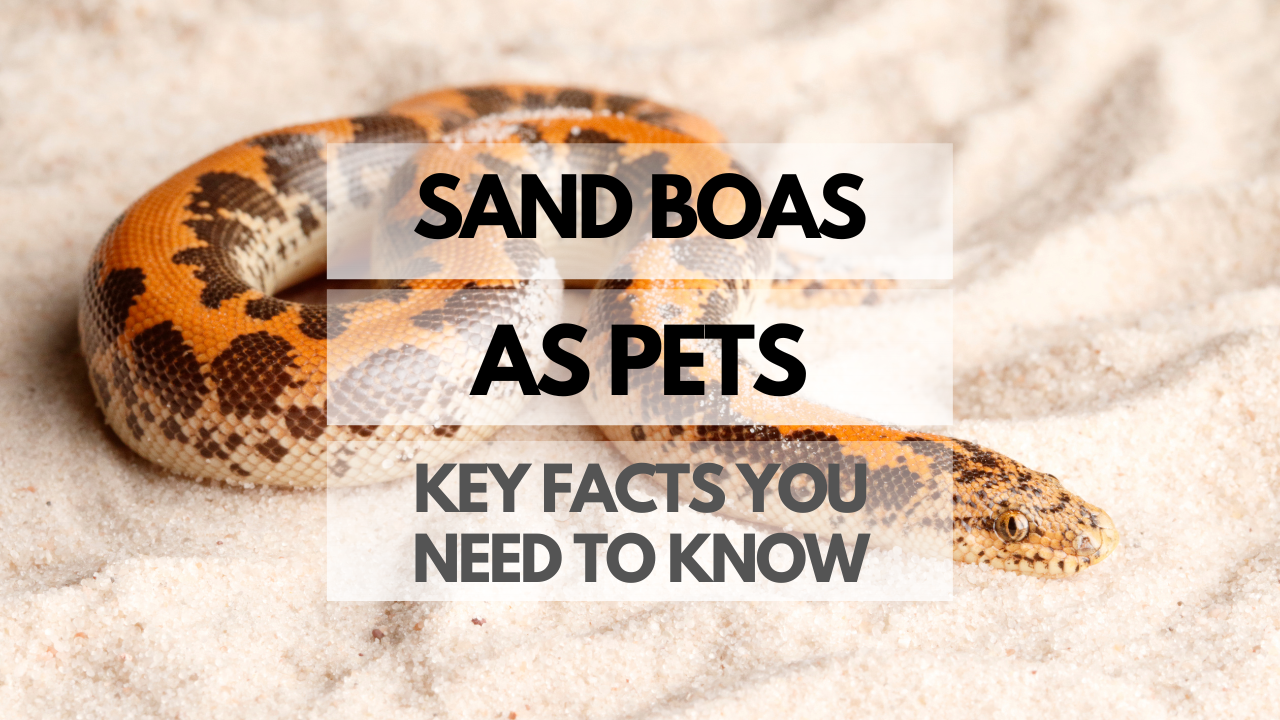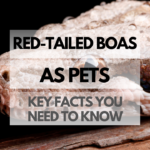Sand Boas are small, docile snakes that have become increasingly popular as pets due to their unique appearance, manageable size, and relatively low maintenance requirements. With a rich history in their native habitats across Africa, Asia, and Europe, these snakes have captured the hearts of reptile enthusiasts around the world.
Quick Reference Table: Sand Boas Facts
| Fact | Description |
|---|---|
| Size | Up to 2-3 feet, depending on the species |
| Lifespan | 15-20 years in captivity |
| Temperament | Docile and easy to handle |
| Diet | Small rodents, such as mice |
| Activity | Nocturnal, burrowing snake |
| Habitat | Deserts and semi-arid regions |
| Conservation Status | Varies by species; some are least concern, while others are vulnerable |
How Are Sand Boas as Pets?
Sand Boas make excellent pets for both beginner and experienced snake keepers. They are generally docile, easy to handle, and have modest care requirements, making them a rewarding pet for those willing to invest time and effort in their care.
Pros and Cons of Sand Boas
Pros:
- Small size makes them easy to house and handle
- Docile temperament
- Minimal space requirements
- Low maintenance compared to larger snakes
Cons:
- Not as interactive as some other reptile pets
- May be difficult to find captive-bred specimens
- Nocturnal, so may not be as active during the day
- Require live or frozen rodents for feeding
Sand Boas Behavior and Temperament
Sand Boas are generally docile and easy to handle, making them ideal pets for those new to snake keeping. They tend to be more active at night and enjoy burrowing in their substrate, so providing an appropriate environment for these behaviors is essential.
How Much Do Sand Boas Cost?
Sand Boas typically cost between $50 and $200, depending on the species and morph. Initial setup costs for a suitable enclosure and necessary equipment can range from $150 to $300. Ongoing expenses include food, substrate replacement, and occasional veterinary care.
Sand Boas Lifespan: Time and Commitment
Sand Boas have a life expectancy of 15-20 years in captivity. It is important to consider this time commitment when deciding to adopt a Sand Boa as a pet. They require regular feeding, cleaning, and handling to ensure they remain healthy and comfortable throughout their lives.
Sand Boas Size
Sand Boas are relatively small snakes, typically reaching lengths of 2-3 feet depending on the species. Their manageable size makes them well-suited for most home environments and easier to handle than larger snake species.
Sand Boas Species
Kenyan Sand Boa
The Kenyan Sand Boa (Eryx colubrinus) is one of the most popular Sand Boa species in the pet trade. They are known for their bold orange and dark brown/black patterns and typically reach lengths of around 2 feet.
Rough-Scaled Sand Boa
The Rough-Scaled Sand Boa (Eryx conicus) is native to India and Pakistan. These snakes have a unique, rough texture to their scales and can grow up to 3 feet in length.
Russian Sand Boa
The Russian Sand Boa (Eryx miliaris) is found in parts of Eastern Europe and Central Asia. They have a more subdued coloration compared to their Kenyan cousins, with a sandy brown or grayish-brown color and dark blotches. They typically reach lengths of around 2 feet.
Sand Boas Colors, Looks and Appearances
Sand Boas exhibit a variety of colors and patterns depending on the species and individual. Common colors include shades of brown, orange, and black, often arranged in distinct patterns or bands. Their unique, stout bodies and partially buried appearance when burrowing make Sand Boas instantly recognizable to many reptile enthusiasts.
Sand Boas Care Guide
Caring for a Sand Boa involves providing a suitable enclosure, maintaining appropriate temperature and humidity levels, offering the right type of food, and ensuring their habitat remains clean and comfortable. With proper care, these snakes can thrive and live long, healthy lives in captivity.
Sand Boas Habitat: Tank and Housing
Appropriate Sand Boa Tank Size
A 20-gallon long tank or enclosure is generally sufficient for most adult Sand Boas. Juveniles can be housed in smaller enclosures, such as a 10-gallon tank, until they grow larger.
Types of Enclosures
Glass aquariums, plastic tubs, or PVC enclosures all work well for housing Sand Boas. The key is to ensure the enclosure has a secure lid to prevent escapes and proper ventilation to maintain air quality.
Substrate Options
Aspen shavings, coconut coir, or a sand/soil mix are suitable substrates for Sand Boas. These materials allow the snake to burrow and maintain their natural behaviors.
Heating and Lighting Requirements
Sand Boas require a temperature gradient in their enclosure, with a warm basking area of around 90-95°F and a cooler side around 75-80°F. Under-tank heating pads or heat tape can be used to provide the necessary heat. While they do not require specialized UVB lighting, a regular day/night light cycle can be beneficial for their overall health.
Humidity and Temperature Control
Maintaining a humidity level of around 30-50% is ideal for Sand Boas. A digital thermometer and hygrometer can help monitor these conditions. Misting the enclosure or providing a humidity box may be necessary during shedding periods to aid in the shedding process.
Furnishings and Decorations
Hide boxes, branches, and artificial plants can be added to the enclosure to provide enrichment and security for your Sand Boa. Ensure all decorations are secure and do not pose a risk of injury to the snake.
Cleaning and Maintenance
Spot cleaning should be performed as needed to remove waste and uneaten food from the enclosure. A full substrate change and thorough cleaning of the tank and furnishings should be done every 1-2 months to maintain a healthy environment for your Sand Boa.
Sand Boas Food: Diet and Nutrition
Feeding Frequency and Schedule
Young Sand Boas should be fed once every 5-7 days, while adult Sand Boas can be fed every 10-14 days. It is important to monitor the snake’s weight and adjust the feeding schedule accordingly to prevent overfeeding or underfeeding.
What do Sand Boas Eat?
Sand Boas primarily eat small rodents, such as mice or young rats. In captivity, it is best to feed them pre-killed or frozen-thawed rodents to minimize the risk of injury to the snake during feeding.
Sand Boas Treats
While rodents should make up the majority of a Sand Boa’s diet, occasional treats like small chicks can be offered as a source of variety and enrichment. However, these should be given sparingly and not as a replacement for their regular meals.
Foods to Avoid
Avoid feeding Sand Boas insects, fish, or other non-rodent prey items, as these do not provide the necessary nutrients for a healthy diet. Additionally, do not feed your Sand Boa live prey, as it can pose a risk of injury to the snake.
Supplements and Vitamins
Sand Boas generally do not require vitamin or mineral supplements, as their diet of whole rodents provides the necessary nutrients. However, consult a reptile veterinarian if you have concerns about your snake’s nutritional needs.
Hydration
Provide a shallow water dish in the Sand Boa’s enclosure for drinking and soaking. Ensure the water is clean and fresh, changing it regularly to prevent bacterial growth.
Handling and Socialization
Taming and Bonding
Regular, gentle handling helps to tame and bond with your Sand Boa. Start with short handling sessions and gradually increase the duration as the snake becomes more comfortable. Always approach the snake calmly and avoid sudden movements to prevent stress.
Safe Handling Techniques
When handling a Sand Boa, support its body and allow the snake to move freely through your fingers. Avoid grasping or squeezing the snake, as this can cause injury or stress. Always wash your hands before and after handling to minimize the risk of transmitting diseases or parasites.
Signs of Stress and Illness
Signs of stress in Sand Boas include excessive hiding, refusal to eat, and aggressive behavior. If you notice these signs, evaluate the snake’s environment and handling practices to identify and address potential stressors. Consult a reptile veterinarian if the symptoms persist or worsen.
Introducing Sand Boas to Other Pets
It is not recommended to house Sand Boas with other pets, as snakes are solitary animals and may become stressed or aggressive in a cohabitated environment. Additionally, other pets may pose a risk of injury or disease transmission to your Sand Boa.
Health and Wellness
Common Health Issues
Some common health issues that may affect Sand Boas include respiratory infections, mites, scale rot, and shedding problems. Regularly monitoring your snake’s health and maintaining a clean, appropriate environment can help prevent these issues.
Signs of a Healthy Sand Boa
A healthy Sand Boa should have clear eyes, a clean and shiny skin, a steady appetite, and regular shedding. They should also be active and alert, with a strong, well-muscled body.
Preventative Care
Preventative care for Sand Boas includes maintaining proper temperature and humidity levels, providing a clean and appropriate habitat, and regularly monitoring the snake’s health. Quarantine new snakes before introducing them to your existing pets to minimize the risk of disease transmission.
Finding a Reptile Veterinarian
It is essential to find a qualified reptile veterinarian who is experienced in treating Sand Boas. Regular checkups and prompt attention to any health concerns can help ensure your snake remains healthy and happy throughout its life.
Breeding and Reproduction
Determining Gender
Sexing Sand Boas can be challenging, as external differences between males and females are subtle. Experienced reptile breeders or veterinarians can often determine gender using a technique called “probing” or by examining the snake’s tail length and shape.
Mating Behavior and Courtship
During the breeding season, male Sand Boas will search forfemales and engage in courtship behavior, such as rubbing their bodies against the female or flicking their tongues. Once the female is receptive, the male will wrap his tail around hers and copulation will occur.
Gravidity and Egg-laying
Sand Boas are ovoviviparous, meaning they give birth to live young instead of laying eggs. A gravid female will generally give birth to 10-20 baby Sand Boas after a gestation period of around 4 months.
Incubation and Hatching
As Sand Boas give birth to live young, there is no need for incubation or hatching. The baby snakes will be born fully developed and ready to begin life independently.
Caring for Hatchlings
Baby Sand Boas should be housed separately from adults and provided with appropriately sized prey items. Monitor their growth and health closely, and adjust their feeding schedule and enclosure conditions as needed.
Are Sand Boas Legal?
Before acquiring a Sand Boa, it is important to check local and regional laws regarding the ownership of these snakes. While they are legal in many areas, some jurisdictions may have restrictions or permit requirements for keeping Sand Boas as pets.
Popular Names for Sand Boas
Choosing a fun and interesting name for your Sand Boa can be a great way to bond with your new pet. Some popular names include: Slinky, Sandy, Houdini, Noodles, Ziggy, and Seraphina. Feel free to get creative and choose a name that reflects your snake’s unique personality!
Conclusion: Should You Own Sand Boas as Pets?
When considering a Sand Boa as a pet, it’s important to understand the responsibility of providing proper care, including appropriate diet, habitat, and handling practices. If you’re prepared to meet these requirements, owning a Sand Boa can be a rewarding and enjoyable experience. These fascinating snakes can make excellent pets for responsible owners who are committed to ensuring their health and happiness throughout their lives.
FAQ for Pet Sand Boas
- Q: Are Sand Boas good pets?
- A: Yes, Sand Boas can make great pets for responsible owners who can provide proper care, including a suitable habitat, diet, and handling practices.
- Q: Can Sand Boas eat grapes, bananas, strawberries, apples, spinach, tomatoes, carrots, cucumbers, watermelon, broccoli, blueberries, celery, cabbage, cilantro, kale, blackberries, oranges, avocados, corn, or asparagus?
- A: No, Sand Boas should not eat these fruits and vegetables. They primarily eat small rodents, such as mice or young rats, which provide the necessary nutrients for a healthy diet.
- Q: How often do Sand Boas eat?
- A: Young Sand Boas should be fed every 5-7 days, while adult Sand Boas can be fed every 10-14 days.
- Q: How long do Sand Boas live?
- A: With proper care, Sand Boas can live for 15-20 years in captivity.
- Q: Where are Sand Boas native?
- A: Sand Boas are native to regions in Africa, the Middle East, and parts of Asia.
- Q: Are Sand Boas friendly?
- A: Sand Boas can be friendly and docile when properly socialized and handled with care.
- Q: Do Sand Boas bite?
- A: While Sand Boas are generally docile, they may bite if they feel threatened or stressed. Proper handling techniques can help minimize the risk of bites.
- Q: Do Sand Boas like to be held?
- A: Sand Boas can become comfortable with gentle handling over time, but it is important to approach them calmly and support their body appropriately.
- Q: Are Sand Boas nocturnal?
- A: Yes, Sand Boas are primarily nocturnal, meaning they are most active during the night.
- Q: Do Sand Boas pee?
- A: Yes, Sand Boas excrete waste in the form of urates, which are solid or semi-solid white substances, along with fecal matter.
- Q: Do Sand Boas hibernate?
- A: Sand Boas do not hibernate, but they may become less active during cooler months or when temperatures in their environment drop.
- Q: Do Sand Boas make noise?
- A: Sand Boas are generally quiet animals, but they may hiss when feeling threatened or stressed.
- Q: Are Sand Boas venomous or poisonous?
- A: No, Sand Boas are non-venomous and not poisonous. They are constrictors, meaning they kill their prey by constriction rather than using venom.
- Q: Are Sand Boas smart?
- A: While it is difficult to measure intelligence in reptiles, Sand Boas are capable of learning and adapting to their environment.
- Q: Do Sand Boas need heat at night?
- A: Yes, Sand Boas require a consistent temperature gradient in their enclosure, including a slightly cooler temperature at night. A heat source should be provided to maintain appropriate temperatures.
- Q: Do Sand Boas lay eggs?
- A: No, Sand Boas are ovoviviparous, meaning they give birth to live young instead of laying eggs.
- Q: Do Sand Boas smell?
- A: Sand Boas do not typically have a strong odor. However, maintaining a clean enclosure and promptly removing waste can help prevent any unpleasant smells.



